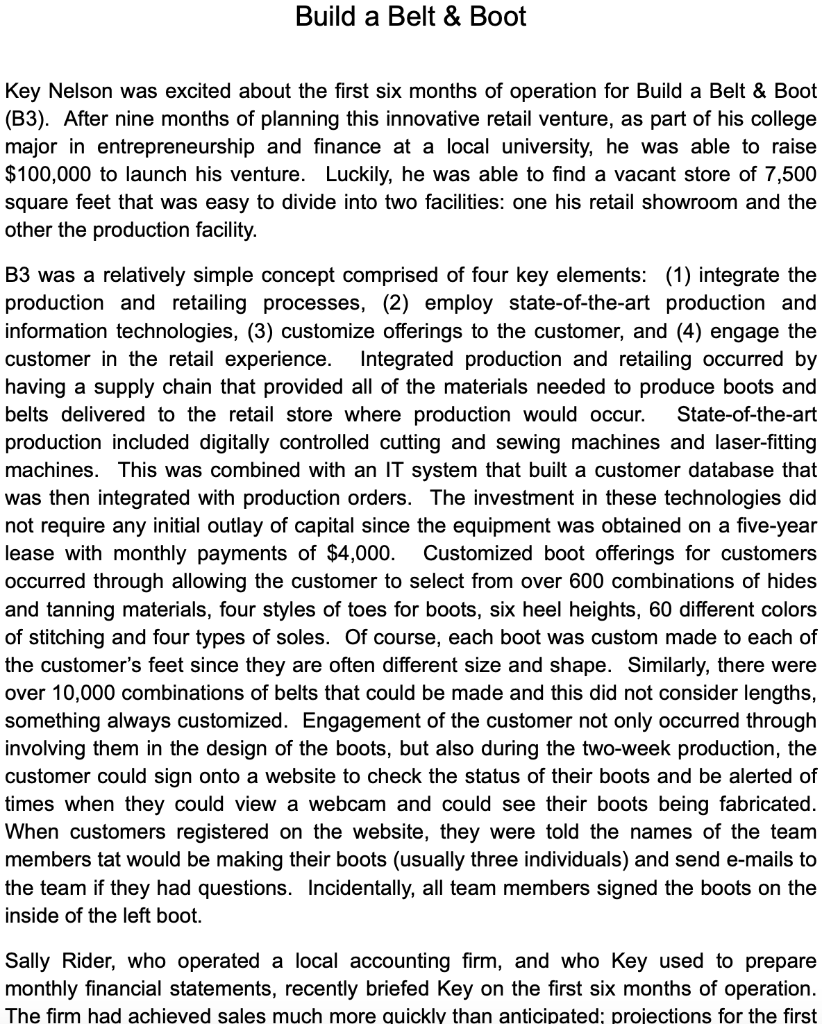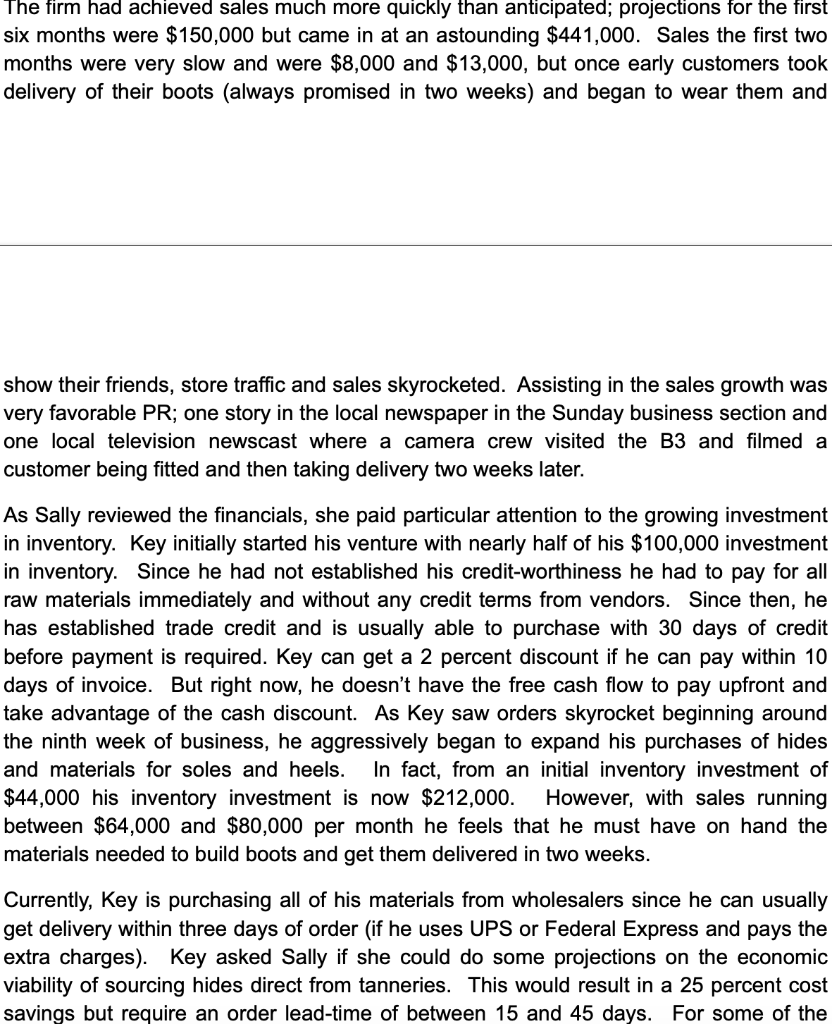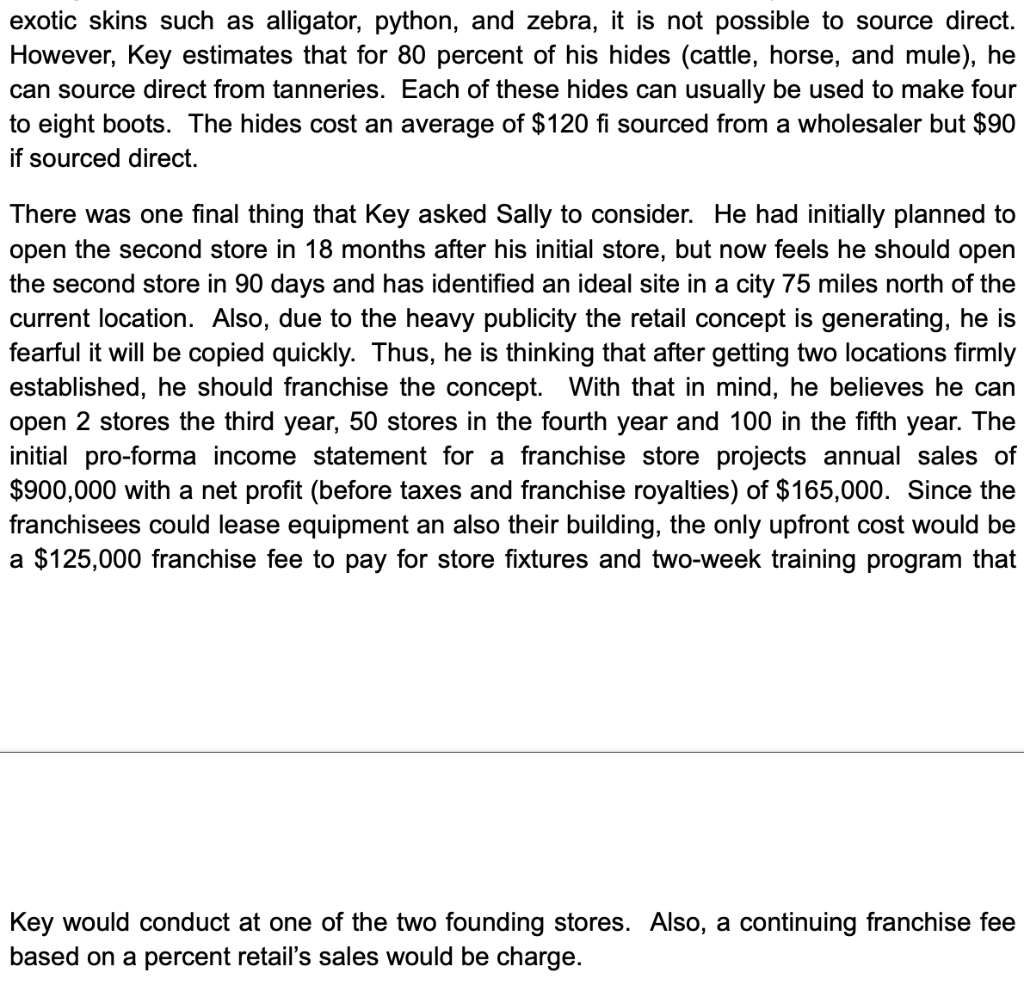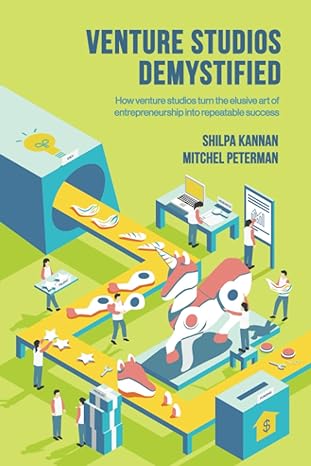Answered step by step
Verified Expert Solution
Question
1 Approved Answer
Would you consider adding other merchandise lines beyond Belt & Boot? If so, what would it be and why would you choose to do so?
Would you consider adding other merchandise lines beyond Belt & Boot? If so, what would it be and why would you choose to do so? If not, why not.



Build a Belt \& Boot Key Nelson was excited about the first six months of operation for Build a Belt \& Boot (B3). After nine months of planning this innovative retail venture, as part of his college major in entrepreneurship and finance at a local university, he was able to raise $100,000 to launch his venture. Luckily, he was able to find a vacant store of 7,500 square feet that was easy to divide into two facilities: one his retail showroom and the other the production facility. B3 was a relatively simple concept comprised of four key elements: (1) integrate the production and retailing processes, (2) employ state-of-the-art production and information technologies, (3) customize offerings to the customer, and (4) engage the customer in the retail experience. Integrated production and retailing occurred by having a supply chain that provided all of the materials needed to produce boots and belts delivered to the retail store where production would occur. State-of-the-art production included digitally controlled cutting and sewing machines and laser-fitting machines. This was combined with an IT system that built a customer database that was then integrated with production orders. The investment in these technologies did not require any initial outlay of capital since the equipment was obtained on a five-year lease with monthly payments of $4,000. Customized boot offerings for customers occurred through allowing the customer to select from over 600 combinations of hides and tanning materials, four styles of toes for boots, six heel heights, 60 different colors of stitching and four types of soles. Of course, each boot was custom made to each of the customer's feet since they are often different size and shape. Similarly, there were over 10,000 combinations of belts that could be made and this did not consider lengths, something always customized. Engagement of the customer not only occurred through involving them in the design of the boots, but also during the two-week production, the customer could sign onto a website to check the status of their boots and be alerted of times when they could view a webcam and could see their boots being fabricated. When customers registered on the website, they were told the names of the team members tat would be making their boots (usually three individuals) and send e-mails to the team if they had questions. Incidentally, all team members signed the boots on the inside of the left boot. Sally Rider, who operated a local accounting firm, and who Key used to prepare monthly financial statements, recently briefed Key on the first six months of operation. The firm had achieved sales much more quicklv than anticipated: proiections for the first The firm had achieved sales much more quickly than anticipated; projections for the first six months were $150,000 but came in at an astounding $441,000. Sales the first two months were very slow and were $8,000 and $13,000, but once early customers took delivery of their boots (always promised in two weeks) and began to wear them and show their friends, store traffic and sales skyrocketed. Assisting in the sales growth was very favorable PR; one story in the local newspaper in the Sunday business section and one local television newscast where a camera crew visited the B3 and filmed a customer being fitted and then taking delivery two weeks later. As Sally reviewed the financials, she paid particular attention to the growing investment in inventory. Key initially started his venture with nearly half of his $100,000 investment in inventory. Since he had not established his credit-worthiness he had to pay for all raw materials immediately and without any credit terms from vendors. Since then, he has established trade credit and is usually able to purchase with 30 days of credit before payment is required. Key can get a 2 percent discount if he can pay within 10 days of invoice. But right now, he doesn't have the free cash flow to pay upfront and take advantage of the cash discount. As Key saw orders skyrocket beginning around the ninth week of business, he aggressively began to expand his purchases of hides and materials for soles and heels. In fact, from an initial inventory investment of $44,000 his inventory investment is now $212,000. However, with sales running between $64,000 and $80,000 per month he feels that he must have on hand the materials needed to build boots and get them delivered in two weeks. Currently, Key is purchasing all of his materials from wholesalers since he can usually get delivery within three days of order (if he uses UPS or Federal Express and pays the extra charges). Key asked Sally if she could do some projections on the economic viability of sourcing hides direct from tanneries. This would result in a 25 percent cost savings but require an order lead-time of between 15 and 45 days. For some of the exotic skins such as alligator, python, and zebra, it is not possible to source direct. However, Key estimates that for 80 percent of his hides (cattle, horse, and mule), he can source direct from tanneries. Each of these hides can usually be used to make four to eight boots. The hides cost an average of $120 fi sourced from a wholesaler but $90 if sourced direct. There was one final thing that Key asked Sally to consider. He had initially planned to open the second store in 18 months after his initial store, but now feels he should open the second store in 90 days and has identified an ideal site in a city 75 miles north of the current location. Also, due to the heavy publicity the retail concept is generating, he is fearful it will be copied quickly. Thus, he is thinking that after getting two locations firmly established, he should franchise the concept. With that in mind, he believes he can open 2 stores the third year, 50 stores in the fourth year and 100 in the fifth year. The initial pro-forma income statement for a franchise store projects annual sales of $900,000 with a net profit (before taxes and franchise royalties) of $165,000. Since the franchisees could lease equipment an also their building, the only upfront cost would be a $125,000 franchise fee to pay for store fixtures and two-week training program that Key would conduct at one of the two founding stores. Also, a continuing franchise fee based on a percent retail's sales would be charge. Build a Belt \& Boot Key Nelson was excited about the first six months of operation for Build a Belt \& Boot (B3). After nine months of planning this innovative retail venture, as part of his college major in entrepreneurship and finance at a local university, he was able to raise $100,000 to launch his venture. Luckily, he was able to find a vacant store of 7,500 square feet that was easy to divide into two facilities: one his retail showroom and the other the production facility. B3 was a relatively simple concept comprised of four key elements: (1) integrate the production and retailing processes, (2) employ state-of-the-art production and information technologies, (3) customize offerings to the customer, and (4) engage the customer in the retail experience. Integrated production and retailing occurred by having a supply chain that provided all of the materials needed to produce boots and belts delivered to the retail store where production would occur. State-of-the-art production included digitally controlled cutting and sewing machines and laser-fitting machines. This was combined with an IT system that built a customer database that was then integrated with production orders. The investment in these technologies did not require any initial outlay of capital since the equipment was obtained on a five-year lease with monthly payments of $4,000. Customized boot offerings for customers occurred through allowing the customer to select from over 600 combinations of hides and tanning materials, four styles of toes for boots, six heel heights, 60 different colors of stitching and four types of soles. Of course, each boot was custom made to each of the customer's feet since they are often different size and shape. Similarly, there were over 10,000 combinations of belts that could be made and this did not consider lengths, something always customized. Engagement of the customer not only occurred through involving them in the design of the boots, but also during the two-week production, the customer could sign onto a website to check the status of their boots and be alerted of times when they could view a webcam and could see their boots being fabricated. When customers registered on the website, they were told the names of the team members tat would be making their boots (usually three individuals) and send e-mails to the team if they had questions. Incidentally, all team members signed the boots on the inside of the left boot. Sally Rider, who operated a local accounting firm, and who Key used to prepare monthly financial statements, recently briefed Key on the first six months of operation. The firm had achieved sales much more quicklv than anticipated: proiections for the first The firm had achieved sales much more quickly than anticipated; projections for the first six months were $150,000 but came in at an astounding $441,000. Sales the first two months were very slow and were $8,000 and $13,000, but once early customers took delivery of their boots (always promised in two weeks) and began to wear them and show their friends, store traffic and sales skyrocketed. Assisting in the sales growth was very favorable PR; one story in the local newspaper in the Sunday business section and one local television newscast where a camera crew visited the B3 and filmed a customer being fitted and then taking delivery two weeks later. As Sally reviewed the financials, she paid particular attention to the growing investment in inventory. Key initially started his venture with nearly half of his $100,000 investment in inventory. Since he had not established his credit-worthiness he had to pay for all raw materials immediately and without any credit terms from vendors. Since then, he has established trade credit and is usually able to purchase with 30 days of credit before payment is required. Key can get a 2 percent discount if he can pay within 10 days of invoice. But right now, he doesn't have the free cash flow to pay upfront and take advantage of the cash discount. As Key saw orders skyrocket beginning around the ninth week of business, he aggressively began to expand his purchases of hides and materials for soles and heels. In fact, from an initial inventory investment of $44,000 his inventory investment is now $212,000. However, with sales running between $64,000 and $80,000 per month he feels that he must have on hand the materials needed to build boots and get them delivered in two weeks. Currently, Key is purchasing all of his materials from wholesalers since he can usually get delivery within three days of order (if he uses UPS or Federal Express and pays the extra charges). Key asked Sally if she could do some projections on the economic viability of sourcing hides direct from tanneries. This would result in a 25 percent cost savings but require an order lead-time of between 15 and 45 days. For some of the exotic skins such as alligator, python, and zebra, it is not possible to source direct. However, Key estimates that for 80 percent of his hides (cattle, horse, and mule), he can source direct from tanneries. Each of these hides can usually be used to make four to eight boots. The hides cost an average of $120 fi sourced from a wholesaler but $90 if sourced direct. There was one final thing that Key asked Sally to consider. He had initially planned to open the second store in 18 months after his initial store, but now feels he should open the second store in 90 days and has identified an ideal site in a city 75 miles north of the current location. Also, due to the heavy publicity the retail concept is generating, he is fearful it will be copied quickly. Thus, he is thinking that after getting two locations firmly established, he should franchise the concept. With that in mind, he believes he can open 2 stores the third year, 50 stores in the fourth year and 100 in the fifth year. The initial pro-forma income statement for a franchise store projects annual sales of $900,000 with a net profit (before taxes and franchise royalties) of $165,000. Since the franchisees could lease equipment an also their building, the only upfront cost would be a $125,000 franchise fee to pay for store fixtures and two-week training program that Key would conduct at one of the two founding stores. Also, a continuing franchise fee based on a percent retail's sales would be charge
Step by Step Solution
There are 3 Steps involved in it
Step: 1

Get Instant Access to Expert-Tailored Solutions
See step-by-step solutions with expert insights and AI powered tools for academic success
Step: 2

Step: 3

Ace Your Homework with AI
Get the answers you need in no time with our AI-driven, step-by-step assistance
Get Started


